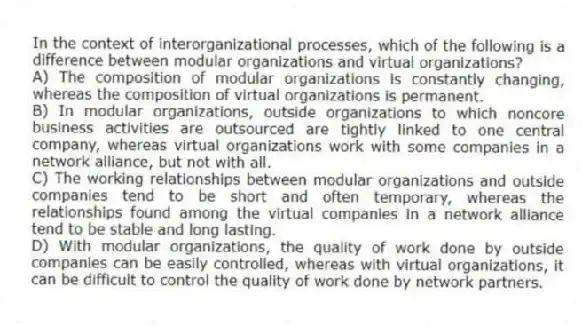
In the context of interorganizational processes, which of the following is a difference between modular organizations and virtual organizations?
A) The composition of modular organizations is constantly changing, whereas the composition of virtual organizations is permanent.
B) In modular organizations, outside organizations to which noncore business activities are outsourced are tightly linked to one central company, whereas virtual organizations work with some companies in a network alliance, but not with all.
C) The working relationships between modular organizations and outside companies tend to be short and often temporary, whereas the relationships found among the virtual companies in a network alliance tend to be stable and long lasting.
D) With modular organizations, the quality of work done by outside companies can be easily controlled, whereas with virtual organizations, it can be difficult to control the quality of work done by network partners.
Correct Answer:
Verified
Q102: In the context of interorganizational processes, which
Q103: Empowering workers means permanently passing decision-making authority
Q104: In a decentralized organization, workers closest to
Q105: Minimal managerial skills are required to make
Q106: A virtual organization is an organization that
Q108: The primary advantage of matrix departmentalization is
Q109: Phillip is a mechanical engineer who works
Q110: Staff functions are activities that directly contribute
Q111: The third transfer that occurs with delegation
Q112: The working relationships between modular organizations and
Unlock this Answer For Free Now!
View this answer and more for free by performing one of the following actions

Scan the QR code to install the App and get 2 free unlocks

Unlock quizzes for free by uploading documents